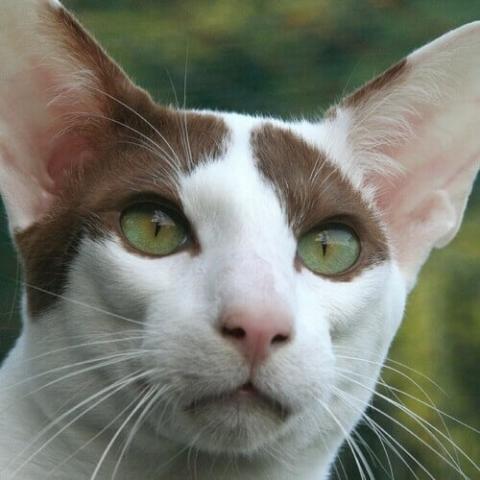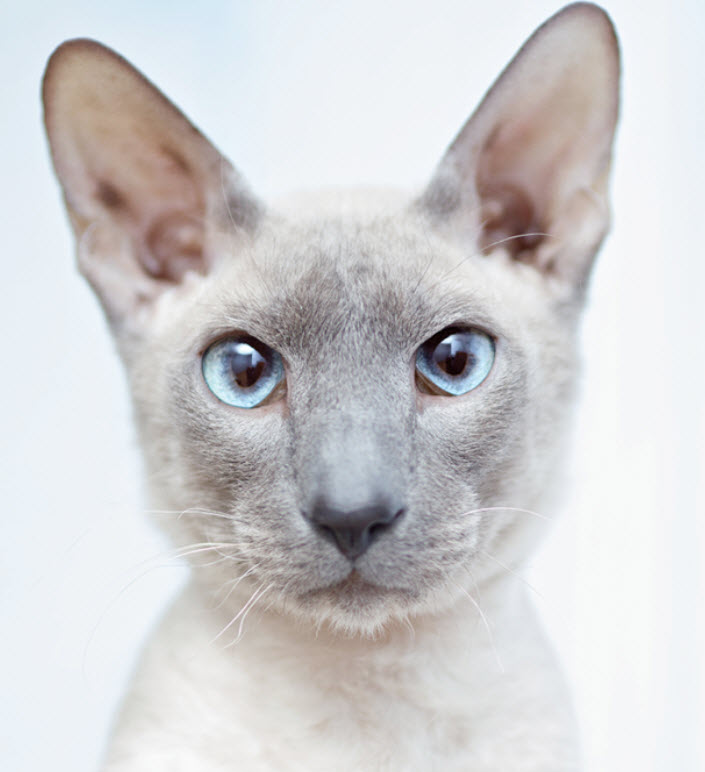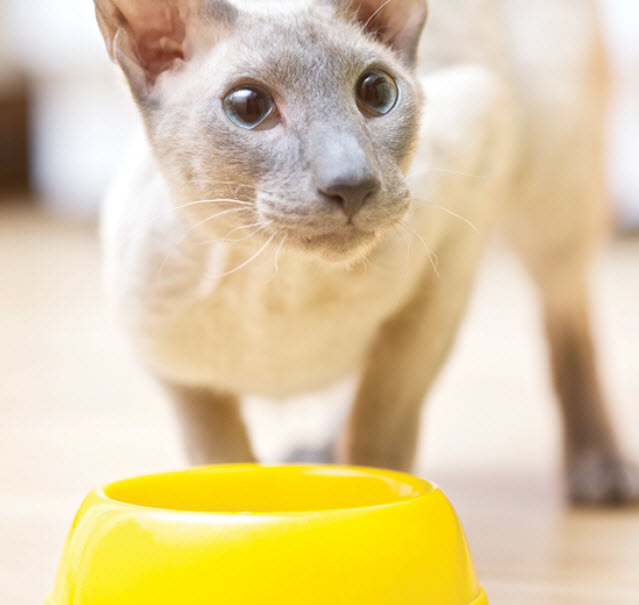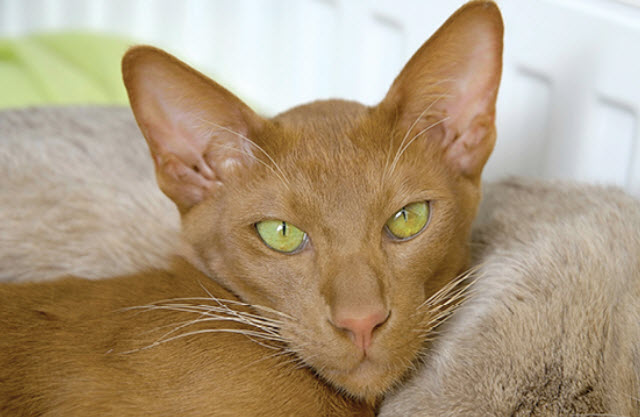
Not a Siamese!
Don't confuse this cat with a Siamese. The Shorthaired Oriental is a breed of its own, with traits like:
- Energetic and playful
- A good companion and pet
- Good with children and other pets
- Loves jumping and being in high places
- May remain playful as a kitten throughout her life
However, she will be sure to find ways to let you know she's around:
- May meow constantly to get your attention
- Very talkative, has an opinion about everything
- May want to constantly be involved in your activities
- People-oriented and should not be left alone for long periods of time
 You'll never be bored with a friend like this! She tries her best to communicate with you and craves your constant attention.
You'll never be bored with a friend like this! She tries her best to communicate with you and craves your constant attention.
The Oriental is a Siamese hybrid that was first developed in England the 1950’s. They are similar in body type to the Siamese and are available in over 300 color and pattern combinations. Orientals develop close bonds with their owners. If they are left alone for long periods they may show signs of depression. Curious and intelligent she will go to great lengths to be involved in your activities. They are more soft-spoken than the Siamese, but this cat loves to chat and will happily carry on a “conversation” with you.
Your Oriental's Health
We at Lombard Veterinary Hospital know that because you care so much about your cat, you want to take great care of her. That is why we have summarized the health concerns we will be discussing with you over the life of your Oriental. By knowing about the health concerns common among Orientals, we can help you tailor an individual preventive health plan and hopefully prevent some predictable risks in your pet.
Many diseases and health conditions are genetic, meaning they are related to your pet’s breed. The conditions we will describe here have a significant rate of incidence or a strong impact upon this breed particularly, according to a general consensus among feline genetic researchers and veterinary practitioners. This does not mean your cat will have these problems, only that she may be more at risk than other cats. We will describe the most common issues seen in Orientals to give you an idea of what may come up in her future. Of course, we can’t cover every possibility here, so always check with us if you notice any unusual signs or symptoms.
This guide contains general health information important to all felines as well as information on genetic predispositions for Orientals. The information here can help you and your pet’s healthcare team plan for your pet’s unique medical needs together. At the end of the article, we have also included a description of what you can do at home to keep your Oriental looking and feeling her best. We hope this information will help you know what to watch for, and we will all feel better knowing that we’re taking the best possible care of your friend.
General Health Information for your Oriental
Weight Management
Obesity is a major disease that contributes to a surprisingly large number of illnesses and deaths in cats.
This revelation is more well-known and well-understood today than in the last few decades, but too many owners are still ignoring the dangers of extra weight on their pets. Excess weight is one of the most influential factors in the development of arthritis, diabetes, and other life-threatening diseases. Everyone knows—many firsthand from personal experience—how even shedding just a few pounds can result in improved mobility and increased overall motivation to be active. And the same is true for your pet.
Research suggests that carrying excess weight may shorten a pet’s life by as much as two years, and can cause the onset of arthritis two years sooner. Diabetes, an inherited disease, has a much higher chance of developing in overweight pets, and may never become a problem for a healthy-weight cat. The more obese a cat becomes, the more likely it will become diabetic. Hepatic lipidosis, or fatty liver, is another potentially fatal disease in overweight pets; hepatic lipidosis can develop in as few as 48 hours when an overweight cat stops eating for any reason.
So how can we help our pets stay trim? Understanding your cat's dietary habits is key. The average cat prefers to eat about 10-15 times a day, just a few nibbles at a time. This method, free-feeding, works well for most cats, but boredom may increase the number of trips your cat makes to the food bowl. By keeping your cat playfully active and engaged, you'll help your pet stay healthy and have some fun at the same time! A string tied to a stick with something crinkly or fuzzy on the other end of the string, and a little imagination—you and your cat will both be entertained. Food puzzles, like kibbles put in a paper bag or under an overturned basket or box, may help to motivate cats with more food-based interests to romp and tumble.
For really tough cases of overeating, you will have to take a firm stance, and regulate your cat’s food intake. Instead of filling your cat’s bowl to the top, follow the feeding guide on the food package and be sure to feed a high-quality adult cat diet as recommended by your vet. Replace your cat's habits of eating when bored with extra playtime and affection. Cats typically adjust their desires for personal interaction by the amount of affection offered to them, so in other words, ignoring your cat means your cat will ignore you. By the same token, loving on and playing with your cat a lot will cause your cat to desire that time with you. A more active cat means a healthier, happier pet—and owner!
 Dental Disease
Dental Disease
Dental disease is one of the most common chronic problems in pets who don’t have their teeth brushed regularly. Unfortunately, most cats don’t take very good care of their own teeth, and this probably includes your Oriental. Without extra help and care from you, your cat is likely to develop potentially serious dental problems. Dental disease starts with food residue, which hardens into tartar that builds up on the visible parts of the teeth, and eventually leads to infection of the gums and tooth roots. Protecting your cat against dental disease from the start by removing food residue regularly may help prevent or delay the need for advanced treatment of dental disease. This treatment can be stressful for your cat and expensive for you, so preventive care is beneficial all around. In severe cases of chronic dental infection, your pet may even lose teeth or sustain damage to internal organs. And, if nothing else, your cat will be a more pleasant companion not knocking everyone over with stinky cat breath! We’ll show you how to keep your cat's pearly whites clean at home, and help you schedule regular routine dental exams.
Vaccine-Preventable Infections
Like all cats, Orientals are susceptible to bacterial and viral infections such as panleukopenia, calicivirus, rhinotracheitis, and rabies, which are preventable through vaccination. The risk of your cat contracting these diseases is high, so the corresponding vaccines are called “core” vaccines, which are highly recommended for all cats. In addition, vaccines are available to offer protection from other dangerous diseases like feline leukemia virus (FeLV). In making vaccination recommendations for your cat, we will consider the prevalence of these diseases in our area, your cat’s age, and any other risk factors specific to her lifestyle.
Parasites
All kinds of worms and bugs can invade your Oriental’s body, inside and out. Everything from fleas and ticks to ear mites can infest her skin and ears. Hookworms, roundworms, heartworms, and whipworms can get into her system in a number of ways: drinking unclean water, walking on contaminated soil, or being bitten by an infected mosquito. Some of these parasites can be transmitted to you or a family member and are a serious concern for everyone. For your feline friend, these parasites can cause pain, discomfort, and even death, so it’s important that we test for them on a regular basis. Many types of parasites can be detected with a fecal exam, so it’s a good idea to bring a fresh stool sample (in a stink-proof container, please) with your pet for her twice-a-year wellness exams. We’ll also recommend preventive medication as necessary to keep her healthy.
Spay or Neuter
One of the best things you can do for your Oriental is to have her spayed (neutered for males). In females, this procedure includes surgically removing the ovaries and usually the uterus; in males, the testicles are surgically removed. Spaying or neutering your pet decreases the likelihood of certain types of cancers and eliminates the possibility of your pet becoming pregnant or fathering unwanted litters. Both sexes usually become less territorial and less likely to roam, and neutering particularly decreases the occurrence of urine spraying and marking behaviors in males. Performing this surgery also gives us a chance, while your pet is under anesthesia, to identify and address some of the diseases your cat is likely to develop. For example, if your pet needs hip X-rays to check for dysplasia or a thorough dental exam to look for stomatitis, these procedures can be conveniently performed at the same time as the spay or neuter to minimize the stress on your cat. Routine blood testing prior to surgery also helps us to identify and take precautions against common problems that increase anesthetic or surgical risk. It sounds like a lot to keep in mind, but don’t worry - we’ll discuss all the specific problems we will look for with you when the time arrives.
Genetic Predispositions for Orientals
 Feline Asthma
Feline Asthma
Asthma, which causes inflammation and narrowing of the small airways of the lungs, is fairly common in cats. Certain cat breeds, including your Oriental, are especially at risk. Asthma is a life-threatening condition that can require emergency treatment. Cats with asthma often have a wheezing cough; some owners may describe it as a “hairball cough,” but really when cats have a hairball, they typically don't cough, they vomit. Coughing is much more likely to be a serious problem in a cat than in a human or a dog, for example, and any cough that lasts longer than a day or recurs over time should be checked out. Cats with asthma can be treated with inhalers as well as oral medications that help open the airways and reduce inflammation. Prompt treatment is needed for wheezing, gasping, coughing or any sign of respiratory distress in your cat.
Multiple Cancers
Cancer is a leading cause of death among cats in their golden years. Many cancers can be cured by surgical removal of any masses and some types are treatable with chemotherapy. Early detection of every type of cancer is critical, so we’ll do periodic blood tests and look for lumps and bumps on your pet at each exam.
- Lymphoma or lymphosarcoma is a type of cancer that afflicts Orientals more than other breeds. This disease causes the body to form abnormal lymphocytes, which are a type of white blood cell. Because white blood cells are found throughout the body, this cancer can show up almost anywhere. Lymphoma is a very treatable form of cancer, and chemotherapy in cats has shown an excellent success rate for recovery. Luckily, lymphoma is one of the few types of cancer that can often be detected with a blood test, so we recommend a complete blood count twice yearly for your adult cat. Also watch for swollen glands (ask us, and we’ll show you where to look), weight loss, or labored breathing, and be sure to call us if you notice any unusual symptoms in your pet.
- Mast cell tumors are a particularly nasty type of skin cancer, and the sooner they are surgically removed the better. Unfortunately, mast cell tumors often look similar to many other kinds of skin lumps and lesions, so it's hard to know when to be concerned. Of all the skin problems found commonly in your Oriental, some may be harmful and some not, but any skin lump, bump, or irritation on your cat is cause enough for concern. All abnormalities should be checked out by the vet, and any suspicious or questionable growths should be surgically removed and tested as soon as possible. Many cancers can be cured by surgically removing their growths, so early evaluation of all skin abnormalities is critical.
Amyloidosis
An amyloid is a type of protein compound that can cause disease by abnormally collecting inside of tissues and organs. It is the same protein that builds up in the brains of human Alzheimer’s patients. In cats, amyloids are more likely to accumulate in the abdominal organs, especially the kidneys, liver, and pancreas. This buildup of protein clogs the organ and causes organ failure. Signs of organ failure may appear on blood or urine tests, but a tissue biopsy is the only way to specifically diagnose amyloidosis as the cause of the failure. There is no effective treatment for amyloidosis as a disease, but we can use diet and medication to support the function of affected organs.
 Megaesophagus
Megaesophagus
The esophagus is the tube that carries food from the mouth into the stomach by a series of contractions after swallowing. If the esophagus doesn't contract properly to move food down, however, it can become stretched out to “mega” size, so that food remains in the esophagus instead of going down into the stomach. Orientals affected by megaesophagus may throw up tube-shaped portions of undigested food. If your cat has any unusual eating behaviors or consistently vomits after eating, be sure to let us know. X-rays can help us determine if your pet has this condition, and special feeding postures, dietary modifications, and sometimes medications can be prescribed to help manage the problem. Unfortunately, cats with megaesophagus commonly inhale bits of food because of the esophagus's nearness to the windpipe and can consequently develop severe pneumonia, so it's important to diagnose megaesophagus and begin proper treatment early.
Progressive Retinal Atrophy
Progressive retinal atrophy (PRA) is an inherited disease in some Oriental bloodlines in which the eyes are genetically programmed to go blind over time. PRA may cause varying degrees of vision loss, but in most cases results in total blindness with no effective treatment or cure. Because this disease is caused by a recessive gene, normal cats can be carriers, and a kitten with normal parents may still develop PRA. Most affected cats begin to show signs of the disease at around one-and-a-half to two years of age. Night blindness comes first, progressing to total blindness over a period of about two to four years. In some breeds, the disease starts even earlier at about two to three weeks of age, resulting in full blindness by about 16 weeks. A genetic test is available to test parents as carriers before breeding; responsible breeders recommend that affected cats and their close relatives should not be used for breeding.
FLUTD
When your cat urinates outside the litter box, you may be annoyed or furious, especially if your best pair of shoes was the location chosen for the act. But don't get mad too quickly—in the majority of cases, cats who urinate around the house are sending signals for help. Although true urinary incontinence the inability to control the bladder muscles, is rare in cats and is usually due to improper nerve function from a spinal defect, most of the time, a cat that is urinating in “naughty” locations is having a problem and is trying to get you to notice. What was once considered to be one urinary syndrome has turned out to be several over years of research, but current terminology gathers these different diseases together under the label of Feline Lower Urinary Tract Diseases, or FLUTD. Many of these diseases cause similar symptoms, for example, a cat with urolithiasis, or bladder stones, shows many of the same symptoms as a cat with a urinary tract infection, which may also present like the symptoms of a blocked tomcat. Watching for any signs of abnormal urination, like urinating on cool surfaces (a tile floor or bathtub, for example), blood in the urine, straining to urinate with little or no urine production, or crying in the litterbox can help you identify the first signs of a FLUTD. If your cat demonstrates any of these symptoms, call us right away for an urgent appointment. Particularly for male cats, if the urethra is blocked with stones or crystals, the cat is not able to expel any urine, which can become an emergency within only a few hours. The inability to urinate is painful and quickly fatal, so if your cat may be blocked, seek emergency care immediately.
Cats are very good at hiding how sick they are, so the early signs of FLUTD are easy to miss. Bringing your cat in for regular urinalysis testing allows us to check for signs of infection, kidney disease, crystals in the urine, and even diabetes. X-rays and ultrasounds can also help detect the presence of stones in the bladder or kidneys. Lower urinary tract disease can be controlled with medications and special diets, though severe cases of FLUTD may also require surgery.
Taking Care of Your Oriental at Home
 Much of what you can do at home to keep your cat happy and healthy is common sense, just like it is for people. Watch her diet, make sure she gets plenty of exercise, regularly brush her teeth and coat, and call us or a pet emergency hospital when something seems unusual (see “What to Watch For” below). Be sure to adhere to the schedule of examinations and vaccinations that we recommend for your pet. During your cat's exams, we’ll perform her necessary “check-ups” and test for diseases and conditions that are common in Orientals. Another very important step in caring for your pet is signing her up for pet health insurance. There will certainly be medical tests and procedures she will need throughout her life and pet health insurance will help you cover those costs.
Much of what you can do at home to keep your cat happy and healthy is common sense, just like it is for people. Watch her diet, make sure she gets plenty of exercise, regularly brush her teeth and coat, and call us or a pet emergency hospital when something seems unusual (see “What to Watch For” below). Be sure to adhere to the schedule of examinations and vaccinations that we recommend for your pet. During your cat's exams, we’ll perform her necessary “check-ups” and test for diseases and conditions that are common in Orientals. Another very important step in caring for your pet is signing her up for pet health insurance. There will certainly be medical tests and procedures she will need throughout her life and pet health insurance will help you cover those costs.
Routine Care, Diet, and Exercise
Build your pet’s routine care into your schedule to help your Oriental live longer, stay healthier, and be happier during her lifetime. We cannot overemphasize the importance of a proper diet and exercise routine for your pet.
- Supervise your pet as you would a young child. Keep doors closed, pick up after yourself, and block off rooms as necessary. This will help keep her out of trouble, off of inappropriate surfaces for jumping, and away from objects she shouldn’t put in her mouth.
- She has a low maintenance single layer coat. Brush as needed, at least weekly for a healthy shine.
- Orientals have generally good teeth, and you can keep them perfect by brushing them at least twice a week!
- Check her ears weekly for wax, debris, or signs of infection and clean when necessary. Don’t worry—we’ll show you how!
- She needs daily play sessions that stimulate her natural desire to hunt and explore. Keep her mind and body active or she may develop behavior issues.
- Cats are meticulously clean and demand a clean litter box. Be sure to provide at least one box for each cat and scoop waste daily.
- It is important that your cat drinks adequate amounts of water. If she won’t drink water from her bowl try adding ice cubes or a flowing fountain.
- Feed a high-quality feline diet appropriate for her age.
- Exercise your cat regularly by engaging her with high-activity toys.
What to Watch For
An abnormal symptom in your pet could be just a minor or temporary issue, but it could also be the sign of serious illness or disease. Knowing when to seek veterinary help, and how urgently, is essential to taking care of your cat. Many diseases can cause cats to have a characteristic combination of symptoms, which together can be a clear signal that your Oriental needs help.
Office Calls
Give us a call for an appointment if you notice any of these types of symptoms:
- Change in appetite or water consumption
- Tartar build-up, bad breath, red gums, or broken teeth
- Itchy skin (scratching, chewing, or licking), hair loss, or areas of shortened fur
- Lethargy, mental dullness, or excessive sleeping
- Fearfulness, aggression, or other behavioral changes
Emergencies
Seek medical care immediately if you notice any of these signs:
- Scratching or shaking the head, tender ears, or ear discharge
- Cloudiness, redness, itching, or any other abnormality involving the eyes
- Inability or straining to urinate; discolored urine
- Asthmatic wheezing
